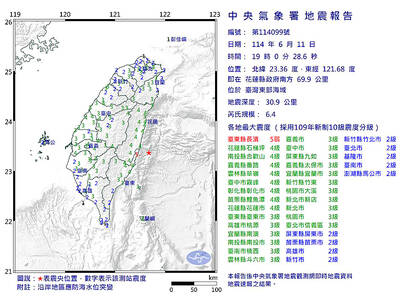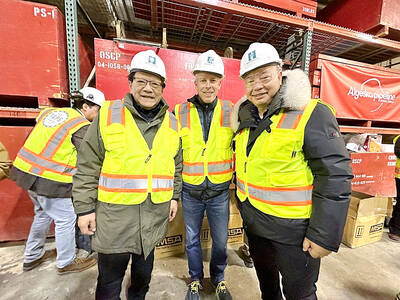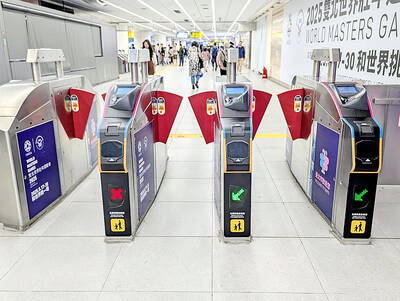An archeology team has uncovered the foundations of a Spanish chapel on an island off northern Taiwan.
Scientists said that it is an important discovery which sheds light on the history of the European colonial era during the 17th century.
The chapel was part of the Fort San Salvador complex on Heping Island (和平島) in a strategic position at the mouth of Keelung harbor and was built by the Spanish during their brief occupation of northern Taiwan more than 300 years ago.

Photo: Lu Hsien-hsiu, Taipei Times
The excavation is an international collaboration between the Academia Sinica, headed by project leader Tsang Cheng-hwa (臧振華), and an archeological research team from Spain.
Tsang, a research fellow at Academia Sinica’s Institute of History and Philology, said three corners of the chapel’s foundations were uncovered at the dig, which is taking place at a parking lot on the island.
He added that skeletal remains of two males were found at the site, one complete skeleton and another which was incomplete. The remains were judged to be contemporaneous with the fort complex.
“Right now we are not sure if the remains belong to the Spanish, or the Formosan Aborigines who were the main inhabitants of the northern coast during that time. So DNA tests will be conducted to determine their origin... It could turn out that these are the oldest evidence of the Spanish occupation yet found in Taiwan,” Tsang said.
Tsang said the dig enabled the team to determine the exact location of the chapel and it correlates with the position shown on maps of the period.
The team found that the Spanish garrison used materials they found on the island to build the chapel, as a section of the wall matched rocks found in nearby hills.
When excavating deeper around the chapel site, the team dug up much older archeological relics dating back to 2,500 to 3,000 years ago, including stone tools, pottery pieces and decorative items made from Taiwanese jade.
“This indicated that ancient civilizations were active on Heping Island and in the whole northern coastal area more than 3,000 years ago. Due to these recent finds, we will expand our excavation efforts around Fort San Salvador in the coming years, because these are important Taiwanese cultural treasures,” Tsang said.
The fort was a key stronghold during the brief Spanish occupation of northern Taiwan in the 17th century.
In 1626, Spain dispatched a fleet of warships from Manila, and sailed to Quelang — the old name for Keelung — as the fort was built that year.
For its defensive fortifications and firepower, at one time Fort San Salvador had 27 copper cannons and six iron cannons, according to Spanish documents.
After some years of battling for trade concessions and colonial holdings, in 1642 Spain ceded the fort to the Dutch, who renamed it Fort Noord-Holland.

A magnitude 6.4 earthquake struck off the coast of Hualien County in eastern Taiwan at 7pm yesterday, the Central Weather Administration (CWA) said. The epicenter of the temblor was at sea, about 69.9km south of Hualien County Hall, at a depth of 30.9km, it said. There were no immediate reports of damage resulting from the quake. The earthquake’s intensity, which gauges the actual effect of a temblor, was highest in Taitung County’s Changbin Township (長濱), where it measured 5 on Taiwan’s seven-tier intensity scale. The quake also measured an intensity of 4 in Hualien, Nantou, Chiayi, Yunlin, Changhua and Miaoli counties, as well as

Credit departments of farmers’ and fishers’ associations blocked a total of more than NT$180 million (US$6.01 million) from being lost to scams last year, National Police Agency (NPA) data showed. The Agricultural Finance Agency (AFA) said last week that staff of farmers’ and fishers’ associations’ credit departments are required to implement fraud prevention measures when they serve clients at the counter. They would ask clients about personal financial management activities whenever they suspect there might be a fraud situation, and would immediately report the incident to local authorities, which would send police officers to the site to help, it said. NPA data showed

ENERGY RESILIENCE: Although Alaska is open for investments, Taiwan is sourcing its gas from the Middle East, and the sea routes carry risks, Ho Cheng-hui said US government officials’ high-profile reception of a Taiwanese representative at the Alaska Sustainable Energy Conference indicated the emergence of an Indo-Pacific energy resilience alliance, an academic said. Presidential Office Secretary-General Pan Men-an (潘孟安) attended the conference in Alaska on Thursday last week at the invitation of the US government. Pan visited oil and gas facilities with senior US officials, including US Secretary of the Interior Doug Burgum, US Secretary of Energy Chris Wright, Alaska Governor Mike Dunleavy and US Senator Daniel Sullivan. Pan attending the conference on behalf of President William Lai (賴清德) shows a significant elevation in diplomatic representation,

The Taipei MRT is to begin accepting mobile payment services in the fall, Taipei Rapid Transit Corp said on Saturday. When the company finishes the installation of new payment units at ticketing gates in October, MRT passengers can use credit cards, Apple Pay, Google Pay and Samsung Pay, the operator said. In addition, the MRT would also provide QR payment codes — which would be compatible with Line Pay, Jkopay, iPass Money, PXPay Plus, EasyWallet, iCash Pay, Taiwan Pay and Taishin Pay — to access the railway system. Currently, passengers can access the Taipei MRT by buying a single-journey token or using EasyCard,